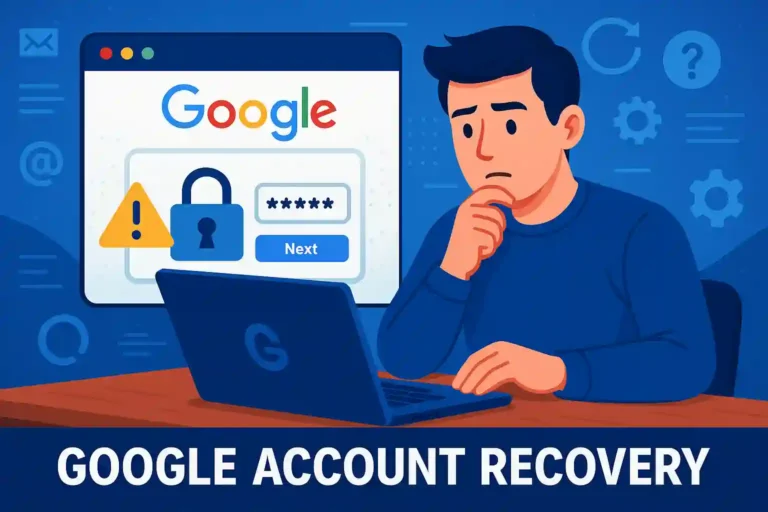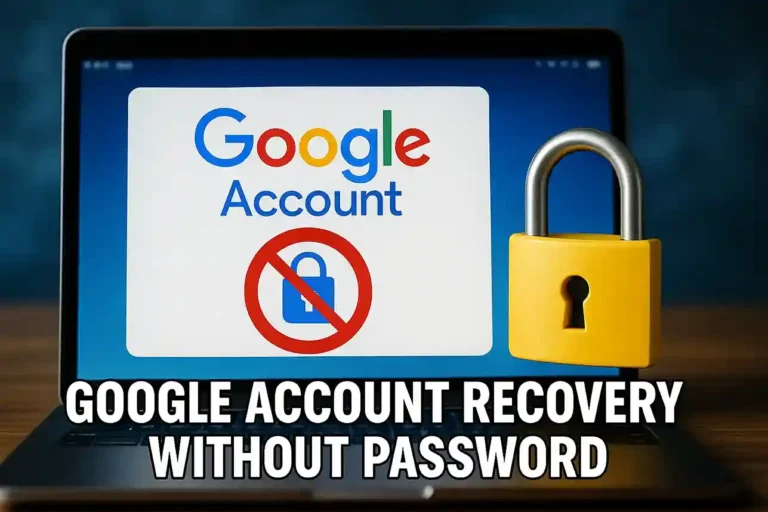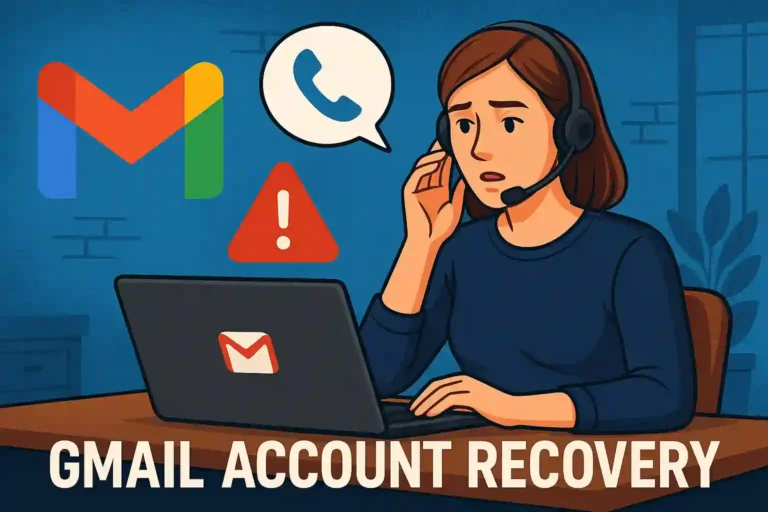How to Recover a Google Account: restore step-by-step
Learning how to recover a Google Account can save you from losing access to important emails and services.
Discover practical recovery methods that work even when you’ve forgotten passwords or lost backup information.
You will remain on the current site.
Begin with these proven techniques to regain control of your account and protect your digital information today.
Understanding Google Account Recovery Options
Google provides multiple pathways for users who need help account access Gmail services after being locked out of their primary email address.
The recovery process adapts to your specific situation, whether you remember some details or have completely lost access to all information.
Modern recovery systems analyze your request and guide you through the most appropriate restoration method based on available verification data.
Essential Email Reset Steps for Quick Recovery
Start the email reset steps by visiting the Google Account Recovery page and entering your email address or phone number associated with the account.
Click “Forgot password” and follow the prompts that appear on your screen, which may include answering security questions or verification codes.
Complete each verification step carefully, as incorrect attempts can delay the recovery process and trigger additional security measures for your protection.
Primary Recovery Methods Available
Google offers several immediate recovery options depending on the security information you previously configured on your account settings.
These methods include backup email verification, SMS codes to registered phone numbers, and answering previously set security questions accurately.
Choose the option that matches your current access to backup information, as this determines the speed of your account restoration process.
Recovering Gmail Without Backup Information
Users facing Gmail without backup access can still recover their accounts through alternative verification methods provided by Google support systems.
The process requires patience as Google verifies your identity through behavioral patterns, device history, and other security indicators you’ve established.
Submit detailed information about your account usage, including recent emails sent, contacts frequently messaged, and approximate account creation dates for verification.
Alternative Verification Techniques
When standard recovery fails, Google analyzes your login history, device fingerprints, and location data to confirm your identity securely.
Provide accurate information about your typical usage patterns, including times you usually check email and devices commonly used for access.
Answer detailed questions about account activity, such as labels you created, important emails received, or Google services you frequently use.
Required Information for Manual Review
Prepare specific details about your account history, including the month and year you created the account if possible.
List email addresses you contacted most frequently and any Google services like Drive or Photos you accessed regularly from this account.
Gather information about recent password changes, security settings modifications, or any suspicious activity you noticed before losing access to the account.
Utilizing Free Gmail Tools for Account Recovery
Gmail tools free options include built-in recovery assistants that guide users through automated restoration processes step by step.
These integrated tools scan your account for available recovery methods and present the most viable options based on your security settings.
Access these utilities directly through the Google sign-in page by selecting “Need help?” and following the interactive recovery wizard.
Built-in Recovery Assistant Features
The recovery assistant evaluates your specific situation and customizes the restoration process based on information available in your account profile.
This tool provides real-time feedback about your recovery attempts and suggests alternative methods when initial approaches don’t succeed immediately.
Follow each recommendation systematically, as the assistant learns from your responses and adapts subsequent suggestions to improve success rates.
When to Contact Gmail Support for Advanced Help
Contact Gmail support when automated recovery methods fail and you need human assistance to resolve complex account access issues.
Support representatives can review your case manually and provide specialized guidance for unique situations that automated systems cannot handle effectively.
Prepare comprehensive documentation about your recovery attempts before reaching out, as this information helps support staff understand your specific situation better.
Preparing for Support Contact
Document all recovery methods you’ve attempted, including error messages received and approximate times you made these attempts for reference.
Compile proof of account ownership such as purchase receipts for Google services, device serial numbers, or other identifying information available.
Create a detailed timeline of events leading to account loss, including any suspicious activity, password changes, or security alerts received.
Information Support Teams Need
The support process requires specific details:
- Complete email address and any associated phone numbers
- Approximate account creation date and location
- Recent emails sent or received that you can recall
- Google services used and frequency of access
- Device information and operating systems typically used
Professional Google Recovery Advice for Complex Cases
Google recovery advice from security experts emphasizes the importance of providing consistent, accurate information throughout the recovery process.
Professional recommendations include using the same device and network location where you typically accessed your account for better verification results.
Experts suggest timing your recovery attempts during hours when you normally check email, as this aligns with your established usage patterns.
Advanced Recovery Strategies
Security professionals recommend gathering evidence of account ownership from multiple sources to strengthen your recovery case significantly.
This includes screenshots of Google service purchases, email confirmations from other accounts, or communication records that reference your Gmail address.
Consider reaching out to frequent email contacts who might have saved emails from your account as additional proof of ownership.
Fixing Common Gmail Login Problems
Learning to fix login Gmail issues often resolves access problems without requiring full account recovery procedures in many cases.
Common solutions include clearing browser cookies, disabling browser extensions, or trying access from different devices to isolate technical problems.
Verify that your internet connection is stable and that you’re entering login credentials correctly, including checking for caps lock activation.
Technical Troubleshooting Steps
Browser-related issues frequently cause login failures that users mistake for account security problems requiring complex recovery procedures.
Clear your browser cache and cookies, then attempt login using incognito or private browsing mode to eliminate stored data conflicts.
Disable ad blockers and browser extensions temporarily, as these tools sometimes interfere with Google’s authentication systems unexpectedly.
Device and Network Considerations
Common technical solutions include:
- Restarting your router and checking internet connectivity
- Updating your browser to the latest version available
- Trying login from a different device or network
- Checking if your employer or school blocks Gmail access
Password Recovery for Email Accounts
Password recover email processes work best when you remember some account details and have access to backup recovery methods previously configured.
Google’s password reset system sends verification codes to backup emails or phone numbers, allowing secure password updates without compromising account security.
Complete the password reset immediately after receiving verification codes, as these expire quickly for security reasons and may require restarting the process.
Creating Strong Replacement Passwords
Choose new passwords that combine uppercase letters, lowercase letters, numbers, and special symbols for maximum security against future attacks.
Avoid using personal information like birthdays, names, or addresses that others might guess or find through social media research.
Consider using password managers to generate and store complex passwords securely, reducing the risk of future lockouts from forgotten credentials.
Step-by-Step Access Gmail Procedures
Following structured access Gmail steps ensures you don’t miss important verification opportunities that could expedite your account recovery process.
Begin each recovery session with accurate information entry and avoid rushing through prompts, as careful attention improves success rates significantly.
Document each step you complete, including any error messages, to avoid repeating unsuccessful attempts that might trigger security delays.
Systematic Recovery Approach
Start recovery during hours when you typically use your email account, as this timing aligns with Google’s behavioral analysis systems.
Use devices and internet connections you’ve previously used to access the account, as familiar digital fingerprints support identity verification.
Provide detailed, honest answers to security questions rather than guessing, as incorrect responses can complicate the recovery process unnecessarily.
Recovery Session Best Practices
Optimize your recovery attempts by following these guidelines:
- Use consistent device and location for all attempts
- Provide accurate information even if you’re uncertain
- Complete each step thoroughly before moving forward
- Keep detailed records of your recovery progress
- Wait recommended time periods between attempts
Restoring Old Gmail Accounts Successfully
The process to restore Gmail old accounts requires additional patience as Google implements extra security measures for dormant email addresses.
Long-inactive accounts often require more extensive verification since usage patterns may be outdated and security information might have changed significantly.
Prepare for a potentially longer recovery timeline when dealing with accounts that haven’t been accessed for months or years before attempting restoration.
Special Considerations for Inactive Accounts
Old accounts may have outdated recovery information like disconnected phone numbers or abandoned backup email addresses that complicate restoration efforts.
Google may require additional verification steps for dormant accounts to ensure legitimate ownership rather than unauthorized access attempts by malicious users.
Gather historical information about the account, including old passwords you remember, early contacts, or significant emails that demonstrate long-term ownership.
Complete Google Guide Stepwise Recovery Process
This comprehensive Google guide stepwise approach ensures you understand each phase of account recovery from initial assessment through final restoration.
Understanding how to recover a Google Account systematically increases your chances of successful restoration while minimizing security risks to your personal information.
Follow each phase completely before advancing to the next step, as rushing through recovery procedures often leads to unnecessary complications.
Phase-by-Phase Recovery Framework
Phase one involves gathering all available account information and selecting the most appropriate recovery method based on your specific circumstances.
Phase two focuses on executing the chosen recovery strategy while documenting results and preparing alternative approaches if needed for backup.
Phase three includes securing your recovered account with updated security settings and backup information to prevent future access issues.
Conclusion
Successfully learning how to recover a Google Account requires patience, accurate information, and systematic approach to available recovery methods.
Most account recovery attempts succeed when users provide consistent, truthful information and follow Google’s verification procedures completely and carefully.
Implement stronger security measures immediately after recovery, including backup emails, phone verification, and regular password updates for protection.
Frequently Asked Questions
How long does Google account recovery typically take?
Standard recovery with backup email or phone takes minutes, while manual review processes can require 3-5 business days for completion.
Can I recover a Gmail account without any backup information?
Yes, Google offers alternative verification through account usage patterns, device history, and detailed account activity questions.
What happens if I can’t remember my security question answers?
Google provides alternative recovery methods including device verification, location analysis, and manual review processes for stuck users.
Is it possible to recover a permanently deleted Google account?
Accounts deleted within 20 days can often be recovered, but permanently deleted accounts cannot be restored after this timeframe expires.
Why does Google ask for so much information during recovery?
Extensive verification protects against unauthorized access attempts and ensures only legitimate account owners regain access to personal information.






